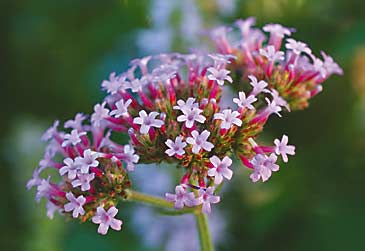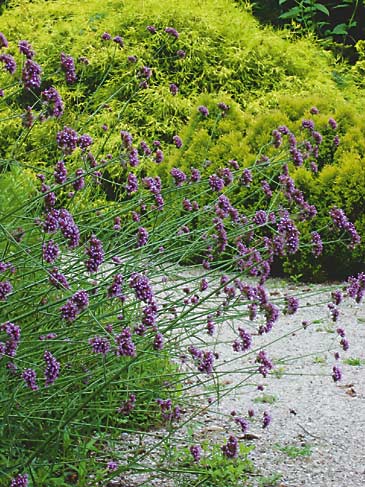 Jonathon Hofley / Michigan Gardener
Jonathon Hofley / Michigan Gardener
Clusters of blooms on long stalks add a delicate touch of color.
by George Papadelis
Tall verbena or Verbena bonariensis is one of those plants that no garden should be without. In a sunny location, its lavender purple flowers will sway in the wind atop 3 to 4 foot tall, wiry stems. It will bloom from spring until late fall since its excellent heat tolerance is followed by equally superb frost tolerance. It doesn’t require staking or deadheading and once established, it will rarely (if ever) require watering. And we’ve really only just begun to describe the merits of this terrific plant, which is treated as an annual in areas zone 6 or colder.
The flowers of tall verbena even drop seeds that will germinate the following spring and could be transplanted to create a repeat performance. It reseeds so prolifically that many gardeners treat this species as a “perennial.” I have had an infinite supply of Verbena bonariensis seedlings in between the pavers of my patio for seven years.
In our quest to create perennial gardens that bloom from spring to fall, we are typically burdened with examining the bloom times of countless perennial varieties. One convenient solution is to incorporate annuals with a “perennial look” that will bloom all season. Tall verbena is the perfect choice. And since it is grown from seed, it is usually available in economical flats as opposed to more expensive individual pots. Planting them in clumps of 6 or more gives the best effect. Space plants about 12 inches apart.
In summer annual beds, tall verbena is equally valuable. Annuals growing over three feet tall in shades of bluish purple are rare; only the tall annual aster (‘Matsumoto Blue’) and blue glory bush (Tibouchina) come to mind, and both of these can be hard to find. The small airy flowers of tall verbena are especially effective when contrasted with composite (daisy-type) flowers. Annual black-eyed Susan varieties (Rudbeckia hirta) offer several great choices in shades of yellow, gold, and orange. The electric orange flowers of the dwarf Mexican sunflower (Tithonia ‘Fiesta del Sol’) would also make a perfect companion. Even the red flowers of the common annual geranium (Pelargonium) look fantastic with tall verbena planted behind them.
 Eric Hofley / Michigan Gardener
Eric Hofley / Michigan Gardener
Verbena bonariensis is most dramatic when planted in drifts.
It wouldn’t be fair to not tell you about a Verbena bonariensis relative that I am sure you will also love. Many of you are probably familiar with the creeping or trailing verbenas that are usually hybrids of Verbena canadensis. These are usually grown from cuttings and perform beautifully in pots and beds. But there is another garden worthy species called Verbena rigida or rigid verbena. These also produce purplish-blue flowers, but the plants are only about a foot tall. Cultivars from cuttings have been available, but now there is a seed-grown variety called ‘Santos Purple.’ It has vibrant purple flowers on 10- to 12-inch tall plants. Its vibrant flowers can be seen from low-flying aircraft and my favorite part is that almost nobody can identify it. Even the most plant-savvy gardeners will ask, “What is it?”, “Is it a perennial?”, “Is it an annual?”. If you appreciate plants that are outstanding performers and that may potentially stump onlookers, then you must have Verbena rigida ‘Santos Purple.’
Both of these verbenas may be tricky to locate but they certainly offer traits that make them well worth the hunt. Try them in your garden and you too will soon be saying, “This is one of those plants no garden should be without.”
George Papadelis is the owner of Telly’s Greenhouse in Troy, MI.
At a glance: Tall verbena
Botanical name: Verbena bonariensis (ver-BEE-nuh bo-nar-ee-EN-sis)
Plant type: Treated as an annual (tender perennial; hardy to zone 7)
Plant size: 3-4 feet tall, 3 feet wide
Habit: Wiry and open
Flower color: Lavender purple
Flower size: Clusters 1 to 1–1/2 inches across
Bloom period: Summer to fall
Light: Sun
Soil: Well-drained
Uses: Annual bed, perennial border
Companion plants: Annual black-eyed Susans, tall cosmos, Mexican sunflower, tall dahlias, daylilies, and many more annuals and perennials.
Remarks: Will reseed readily. Unwanted seedlings are easy to pull out. Although it is tall, can be used in the middle or even front of beds due to its open growth habit. Blooms appear to float in the breeze. Tolerates some frost.
